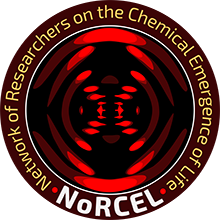A scenario for an origin of life in a hot spring setting has undergone significant experimental testing over the past decade (Damer and Deamer, 2015, 2020). Laboratory and field studies demonstrated that RNA-like polymers can be synthesized nonenzymatically from their monomers by cycles of hydration and dehydration (Rajamani et al., 2008). Cycling conditions simulate fluctuating fresh water hot spring pools in hydrothermal fields associated with volcanic land masses. Recent investigations of the 3.48Ga Dresser Formation in Western Australia discovered geyserite bedded with well-preserved stromatolites (Djokic et al., 2017), suggesting that some of the earliest evidence for life is consistent with thriving microbial populations in fresh water hot springs on land rather than solely in salty marine conditions.
Computational studies used thermodynamic and kinetic analysis to confirm that phosphodiester bonds can form spontaneously (Ross and Deamer, 2016). The free energy is made available by evaporation that concentrates and polymerizes monomers in thin films on mineral surfaces. The polymers become encapsulated by budding of lipid vesicles during rehydration cycles. The resulting protocells can be subjected to combinatorial selection which promotes the emergence of increasingly functional polymer sets. The collaboration that is investigating the hot spring hypothesis (HSH) has developed a number of new directions and the following proposals will be presented: 1. Membrane-bound polymer sets are models of prebiotic protocells; 2. Aggregates of protocells represent a primitive version of a progenote, defined as a self-assembled niche that supports chemical networks, growth and adaptation; 3. A hierarchy of reaction networks can emerge spontaneously as protocell populations respond to environmental stresses. Each of these proposals carries predictions and can inform future experimental testing.
Bruce Damer, University of California at Santa Cruz, Department of Biomolecular Engineering, Santa Cruz CA, USA


